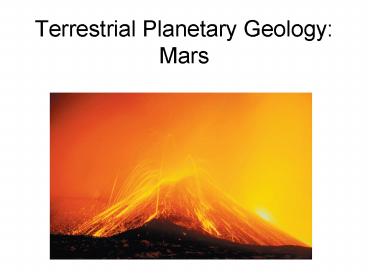Terrestrial Planetary Geology: Mars - PowerPoint PPT Presentation
Title:
Terrestrial Planetary Geology: Mars
Description:
Radius is 3394 km or 0.53 of Earth (angular diameter at opposition) ... 700 km diameter; 25 km high; 80 km wide caldera -- way bigger than any on earth. WHY? ... – PowerPoint PPT presentation
Number of Views:370
Avg rating:3.0/5.0
Title: Terrestrial Planetary Geology: Mars
1
Terrestrial Planetary GeologyMars
2
MARS
- Earths Little Brother
- The Mostly Likely Place to Find Extraterrestrial
Life
3
Basic Martian Properties
- Mass is 0.106 that of Earth (via Phobos Deimos)
- Radius is 3394 km or 0.53 of Earth (angular
diameter at opposition) Density is 3.93
g/cm3 or 0.71 of Earth ?a different interior
from Earth, Venus or Mercury. - As seen from Earth, Mars is Closest at
opposition some details visible from Earth. - Much fainter than Venus further from Sun,
smaller and lower albedo (.15 vs .70) all make
Mars fainter.
4
Mars Orbit
5
Martian Day and Seasons
- Martian day 24.6 h
- equatorial tilt 24.0 degrees -- both close to
Earth THEREFORE MARS HAS SEASONS TOO. - Mainly red/orange surface with variable markings
- Shifting dunes change markings --- not canals and
vegetation (as argued by Lowell) - Polar caps variable parts are mostly CO2, not
H2O Latest measurements indicate most of both
permanent (residual) caps is water ice.
Atmosphere gains and loses carbon dioxide from
the caps.
6
Views of Mars
Pic-du-Midi, Hubble Space Telescope, Viking
pictures
7
MARTIAN TOPOGRAPHY
- S. Hemisphere higher by several km heavily
cratered - N. Hemisphere mostly volcanic plains
(maria) probably only 3 billion years old,
vs. 4 billion years for S - Tharsis bulge --- near equator and 10 km
higher. 4 big volcanoes on Tharsis and 100s of
good sized ones - N hemisphere and Tharsis indicate early (or
failed) tectonics
8
N/S hemispheres Martian map
9
Olympus Mons Volcanic King
- 700 km diameter 25 km high 80 km wide caldera
-- way bigger than any on earth. WHY? - Lower gravity allows greater height and lack of
tectonic motion allows huge build-up (vs Hawaii).
10
Polar Caps
- S cap residual about 350 km diameter
- N cap residual about 1000 km across dustier and
warmer. - Variable CO2 residual H2O
11
Marss Interior Structure
- CRUST some 100 km thick
- MANTLE some 2050 km thick -- not plastic now
- CORE some 1250 km in radius --- FeS
- No bulk MAGNETIC FIELD ? no liquid and/or no pure
Fe/Ni (since it does spin fast) - Percentage-wise less metal than other
terrestrial planets - Mars is small, and it cooled off too fast to
establish plate tectonics
12
THE BIGGEST CANYONS
- Mariners 4 and 7, Viking, Global Surveyor, and
- Pathfinder showed Mars has large Canyons due to
TECTONIC FRACTURES - Valles Marineris, near Tharsis bulge (vs Grand
Canyon) - 2 billion yrs old 4 km deep 4000 km long 120
km wide
13
Real Canyons ? (Was) Running Water
- RUNOFF CHANNELS, that merge like river valleys
(Mars vs Red River) about 400 km long by 5 km
wide
14
Outflow Channels Huge Flood Relics
15
FLUIDIZED EJECTA near IMPACT CRATERS
- Lunar crater (Copernicus) shows dry ejecta
- Martian crater (Yuty) shows liquid/mud flows
- Martian craters erode much faster than lunar
ones windblown dust meteorites
16
Liquid Water on Mars NOW?
- Recent images MAY indicate CURRENT SEEPAGE OF
WATER from PERMAFROST
17
MARS HAS PUNY MOONS
- Discoverd by Asaph Hall in 1877, these are
probably captured asteroids since densities are
low (2 g/cm3 ). - Phobos (fear) 28 x 20 x 8 km a 9378 km P
7h 39m ? backwards orbit - Deimos (panic) 16 x 10 x 6 km a 23,459 km
P 30h 18m ? slow
18
Spacecraft on Mars
- Vikings in 1976 Pathfinder/Sojourner in 1997
Spirit Opportunity in 2004 - Red color from Fe2O3 --- rust
- Plains covered with boulders and rocks. Some
sharp, some smooth and eroded - Pathfinder site rocks deposited by old flood
- Spirit and Opportunity have drilled into rocks
and gone into craters chemistry demands water
was present.
19
Viking 1 2 Pathfinder Surface Photos
20
Spirit Opportunity Views Lion King
panorama, crater wall cliff, drilling site
hematite crystals
21
LIFE on MARS?
- The VIKING LANDERS, in 1976 conducted the only
detailed studies so far - Photos showed nothing moving.
- Gas-chromatograph/mass-spectrometer showed no
organic compounds. - Gas-exchange and pyrolytic release experiments
search for metabolism and gave positive results
(O2 and C, respectively), - but sterilized samples also gave off gases
- Both anomalous results are probably due to UV
irradiated soil and water yielding hydrogen
peroxide (H2O2). - Labeled release experiment gave off radioactive
gas while sterilized soil didn't. - Probably due to C2O3 -- carbon suboxide.
22
Meteoritic Evidence for Fossil Life?
- Meteorite ALH84001, found in Antarctica, came
from Mars it provided controversial evidence for
bacterial fossils Rock structures similar to
bacterial products PAHs Magnetite found where
carbonate dissolved Rod-like structures --- but
very (too?) small! - Most investigators think that ALL this "EVIDENCE"
of life on Mars is NOT CONCLUSIVE and could be
explained by INORGANIC CHEMISTRY. WE NEED TO LOOK
FURTHER!































